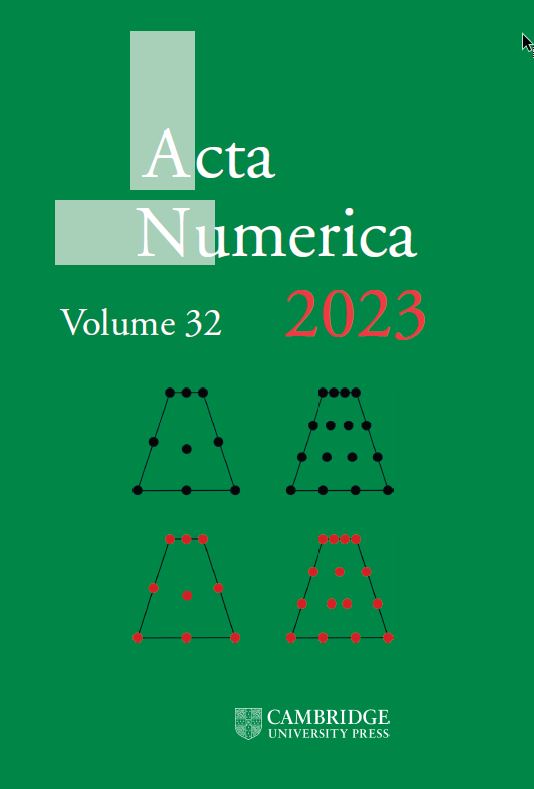Approximation of high-dimensional parametric PDEs *
IF 11.3
1区 数学
Q1 MATHEMATICS
引用次数: 236
Abstract
Parametrized families of PDEs arise in various contexts such as inverse problems, control and optimization, risk assessment, and uncertainty quantification. In most of these applications, the number of parameters is large or perhaps even infinite. Thus, the development of numerical methods for these parametric problems is faced with the possible curse of dimensionality. This article is directed at (i) identifying and understanding which properties of parametric equations allow one to avoid this curse and (ii) developing and analysing effective numerical methods which fully exploit these properties and, in turn, are immune to the growth in dimensionality. Part I of this article studies the smoothness and approximability of the solution map, that is, the map $a\mapsto u(a)$ , where $a$ is the parameter value and $u(a)$ is the corresponding solution to the PDE. It is shown that for many relevant parametric PDEs, the parametric smoothness of this map is typically holomorphic and also highly anisotropic, in that the relevant parameters are of widely varying importance in describing the solution. These two properties are then exploited to establish convergence rates of $n$ -term approximations to the solution map, for which each term is separable in the parametric and physical variables. These results reveal that, at least on a theoretical level, the solution map can be well approximated by discretizations of moderate complexity, thereby showing how the curse of dimensionality is broken. This theoretical analysis is carried out through concepts of approximation theory such as best $n$ -term approximation, sparsity, and $n$ -widths. These notions determine a priori the best possible performance of numerical methods and thus serve as a benchmark for concrete algorithms. Part II of this article turns to the development of numerical algorithms based on the theoretically established sparse separable approximations. The numerical methods studied fall into two general categories. The first uses polynomial expansions in terms of the parameters to approximate the solution map. The second one searches for suitable low-dimensional spaces for simultaneously approximating all members of the parametric family. The numerical implementation of these approaches is carried out through adaptive and greedy algorithms. An a priori analysis of the performance of these algorithms establishes how well they meet the theoretical benchmarks.高维参数偏微分方程的近似
偏微分方程的参数化族出现在各种背景下,如逆问题、控制和优化、风险评估和不确定性量化。在大多数这些应用中,参数的数量很大,甚至可能是无限的。因此,这些参数问题的数值方法的发展面临着可能的维数诅咒。本文旨在(i)识别和理解参数方程的哪些属性允许人们避免这种诅咒,以及(ii)开发和分析有效的数值方法,这些方法充分利用这些属性,从而不受维数增长的影响。本文第一部分研究了解映射的光滑性和近似性,即映射$a\mapsto u(a)$,其中$a$为参数值,$u(a)$为PDE的对应解。结果表明,对于许多相关的参数偏微分方程,该映射的参数平滑性是典型的全纯的,并且具有高度的各向异性,因为相关参数在描述解时的重要性变化很大。然后利用这两个性质来建立解映射的n项近似的收敛率,其中每个项在参数变量和物理变量中是可分离的。这些结果表明,至少在理论层面上,解图可以通过中等复杂性的离散化很好地近似,从而显示了如何打破维数诅咒。这种理论分析是通过近似理论的概念进行的,如最佳n项近似、稀疏性和n宽度。这些概念先验地决定了数值方法的最佳性能,从而作为具体算法的基准。本文的第二部分转向基于理论上建立的稀疏可分近似的数值算法的发展。所研究的数值方法可分为两大类。第一种方法根据参数使用多项式展开来近似解映射。第二步是寻找合适的低维空间来同时逼近参数族的所有成员。通过自适应和贪心算法对这些方法进行了数值实现。对这些算法性能的先验分析确定了它们满足理论基准的程度。
本文章由计算机程序翻译,如有差异,请以英文原文为准。
求助全文
约1分钟内获得全文
求助全文
来源期刊

Acta Numerica
MATHEMATICS-
CiteScore
26.00
自引率
0.70%
发文量
7
期刊介绍:
Acta Numerica stands as the preeminent mathematics journal, ranking highest in both Impact Factor and MCQ metrics. This annual journal features a collection of review articles that showcase survey papers authored by prominent researchers in numerical analysis, scientific computing, and computational mathematics. These papers deliver comprehensive overviews of recent advances, offering state-of-the-art techniques and analyses.
Encompassing the entirety of numerical analysis, the articles are crafted in an accessible style, catering to researchers at all levels and serving as valuable teaching aids for advanced instruction. The broad subject areas covered include computational methods in linear algebra, optimization, ordinary and partial differential equations, approximation theory, stochastic analysis, nonlinear dynamical systems, as well as the application of computational techniques in science and engineering. Acta Numerica also delves into the mathematical theory underpinning numerical methods, making it a versatile and authoritative resource in the field of mathematics.
 求助内容:
求助内容: 应助结果提醒方式:
应助结果提醒方式:


